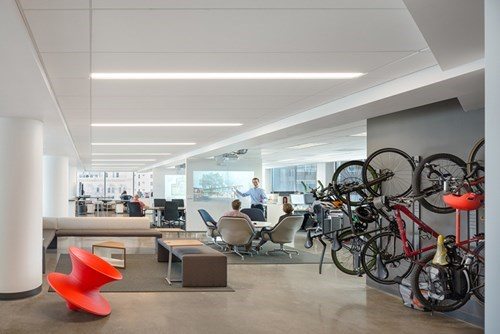by Melissa Spearman
Today’s unprecedented talent shortage is compelling businesses and other organizations to get serious about employee attraction and retention. The current war for talent is amplified by a strong economy and a growing number of Baby Boomers nearing retirement age. In Nebraska, for example, more than 65 percent of state government employees are expected to retire in the next five years. Many private-sector businesses are experiencing similar human-resource challenges.
Within this highly competitive landscape, the workplace can be a strategic asset that distinguishes an organization as an exceptional employer. This is particularly true when attracting professionals between the ages of 20 and 40, according to a recent DLR Group survey. For younger employees, the physical work environment ranks in the top three factors that influence their decisions to join a specific company.

Based on our experience designing workplaces for diverse organizations worldwide, we’ve uncovered several common factors that mobilize a workplace to attract and retain employees.
Convey Organizational Values
People want to work for organizations with a clear mission and vision for the future. Purposeful workplaces engage employees by providing experiential environments that visually communicate a company’s core values and culture.
Customize for Employees
Effective workplaces are designed to support the unique roles, work styles, and personalities of each individual. These offices provide a range of space types, furnishings, and multi-functional common areas, such as a café that also functions as a meeting and event space.

Enable Current and Future Technology
Robust technology infrastructure is vital to support a tech-savvy, mobile workforce. Employees expect reliable wireless access, sophisticated audio-visual equipment, and the latest platforms. The workplace must also have built-in flexibility to accommodate future technology advances.
Support Health and Wellness
High-performance workplaces emphasize occupant health and well-being. The WELL Building Standard, for example, is a valuable tool for ensuring a space focuses on indoor air quality, lighting, water, nourishment, and other factors that contribute to a healthy work environment.
Offer Meaningful Amenities
Understanding the demographics and values of its people can enable employers to hone in on the amenities they value most. These can range from on-site food and entertainment options, to pet daycare, to free parking. It can help to be mindful of the amenities offered by competitors.

Give Employees Control of Their Environment
Whether employees work in an enclosed office or an open workspace, they like to control their environment, including lighting levels, heating and cooling controls, and technology components. They also want a simple, effective process for reserving conference rooms and other spaces.
Allow People to be Themselves
Many view the workplace as a second home, so employees are drawn to comfortable environments where they can work, socialize, and simply be themselves. Engaging workplaces integrate connection points and collaboration zones where people can interact with their colleagues.
While each employee has unique workplace expectations, they all want to feel engaged and connected to the mission of their employer. And when they do, they’re less likely to seek other opportunities.
